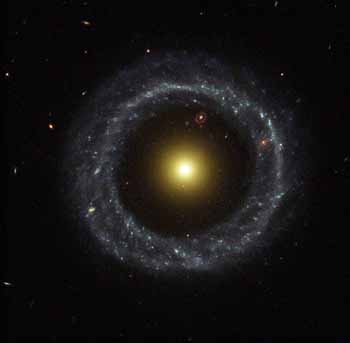A galactic circle surrounding a dense core, a phenomenon known as the Hog object
Direct link to this page: https://www.hayadan.org.il/314152007.html

A cluster of bright blue stars is at the yellow center of one of the strangest galaxies ever observed by the Hubble Space Telescope, which has been in space for nearly 15 years.
The width of the galaxy in question is about 120 light years, slightly larger than our Milky Way. The ring is a collection of hot young stars, while the interior of the galaxy contains much older, cold stars.
The black space between the bright circle and the nucleus could contain star clusters too faint to be seen from Earth, Hubble Space Telescope Science Center researchers say.
We see the galaxy from the front, and thus much more detail is revealed to us than in any other image of this type of object. "This image may help astronomers uncover clues about how such galaxies formed." said in a press release issued by the scientific center.
Such constellations can develop in an infinite number of possible processes, the astronomers say. In some cases, one galaxy may pass through another galaxy, thus creating a compressed period of a cluster of bright stars.
This particular galaxy has no sign of a collision with another galaxy. Some scientists have theorized that the circle of blue stars originates from the remnants of a galaxy that passed near the central galaxy, 2-3 billion years ago.
In 1950, astronomer Art Hoag discovered this galaxy called the Hoag Object. It is about 600 million light-years away from Earth in the direction of the constellation Serpens.
The photo was taken with a wide-field camera in July 2001, and was published by the Hubble heritage team a few days ago.
